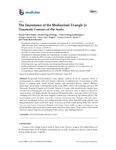Mostrar o rexistro simple do ítem
The importance of the mediastinal triangle in traumatic lesions of the aorta
| dc.contributor.author | Gulías Soidán, Daniel | |
| dc.contributor.author | Fraga-Manteiga, Daniel | |
| dc.contributor.author | Mosquera Rodríguez, Víctor Xesús | |
| dc.contributor.author | Marini Díaz, Milagros | |
| dc.contributor.author | López Bargiela, Paula | |
| dc.contributor.author | González-Martín, Cristina | |
| dc.contributor.author | Balboa-Barreiro, Vanesa | |
| dc.date.accessioned | 2019-06-19T13:43:44Z | |
| dc.date.available | 2019-06-19T13:43:44Z | |
| dc.date.issued | 2019 | |
| dc.identifier.citation | Gulias-Soidan, D.; Fraga-Manteiga, D.; Mosquera-Rodriguez, V.X.; Marini-Diaz, M.; Lopez-Bargiela, P.; González-Martín, C.; Balboa-Barreiro, V. The Importance of the Mediastinal Triangle in Traumatic Lesions of the Aorta. Medicina 2019, 55, 263. | es_ES |
| dc.identifier.issn | 1010-660X | |
| dc.identifier.uri | http://hdl.handle.net/2183/23263 | |
| dc.description.abstract | [Abstract] Background: Trauma-induced aortic injuries continue to be an important factor in morbimortality in patients with blunt trauma. Objectives: To determine the characteristics of aortic lesions in patients with closed thoracic trauma and associated thoracic injuries. Methods: Multicenter cohort study conducted during the years 1994 to 2014 in the radiology service in the University Hospital Complex of A Coruña. Patients >15 years with closed thoracic trauma were included. Sociodemographic and clinical variables were studied in order to determine the lesion cause, location, and degree. Results: We analyzed 232 patients with a mean age of 46.9 ± 18.7 years, consisting of 81.4% males. The most frequent location was at the level of the isthmus (55.2%). The most frequent causes of injury were traffic accidents followed by falls. Patients with aortic injury had more esophageal, airway, and cardiopericardial lesions. More than 85% of the patients had lung parenchyma and/or chest wall injury, which was more prevalent among those who did not have an aortic lesion. Conclusions: Patients with trauma due to traffic accidents or being run over presented three times more risk of aortic injury than from other causes. Those with an aortic lesion also had a higher frequency of cardiopericardial, airway, and esophageal lesions. | es_ES |
| dc.language.iso | eng | es_ES |
| dc.publisher | MDPI | es_ES |
| dc.relation.uri | 10.3390/medicina55060263 | es_ES |
| dc.rights | Creative Commons Attribution (CC BY 4.0) license | es_ES |
| dc.rights.uri | http://creativecommons.org/licenses/by/4.0/ | * |
| dc.subject | Aorta | es_ES |
| dc.subject | Blunt trauma | es_ES |
| dc.subject | Thoracic trauma | es_ES |
| dc.title | The importance of the mediastinal triangle in traumatic lesions of the aorta | es_ES |
| dc.type | info:eu-repo/semantics/article | es_ES |
| dc.rights.access | info:eu-repo/semantics/openAccess | es_ES |
| UDC.journalTitle | Medicina | es_ES |
| UDC.volume | 55 | es_ES |
| UDC.issue | 6 | es_ES |
Ficheiros no ítem
Este ítem aparece na(s) seguinte(s) colección(s)
-
GI-EC - Artigos [11]
-
GI-GIRS - Artigos [101]






